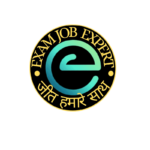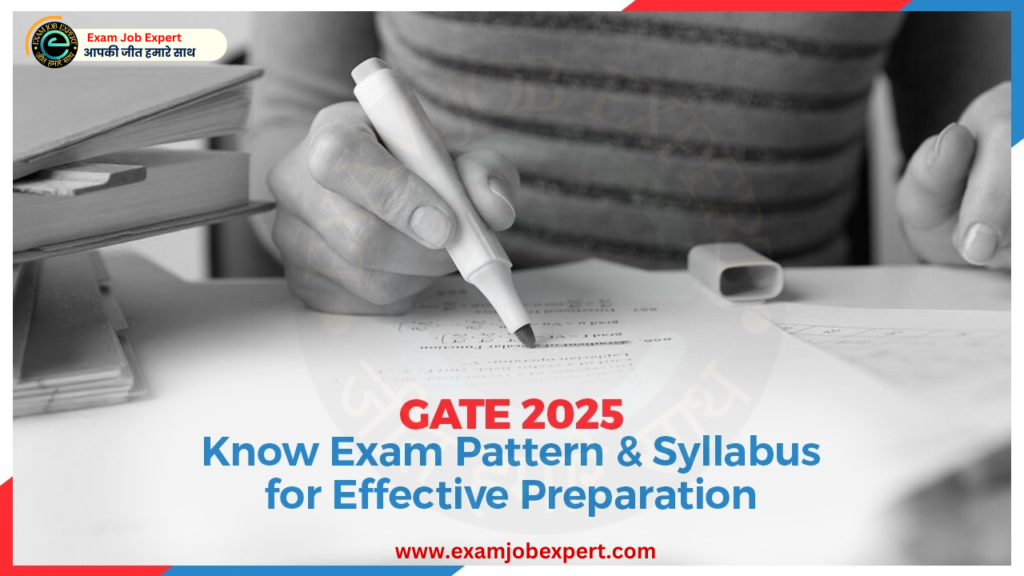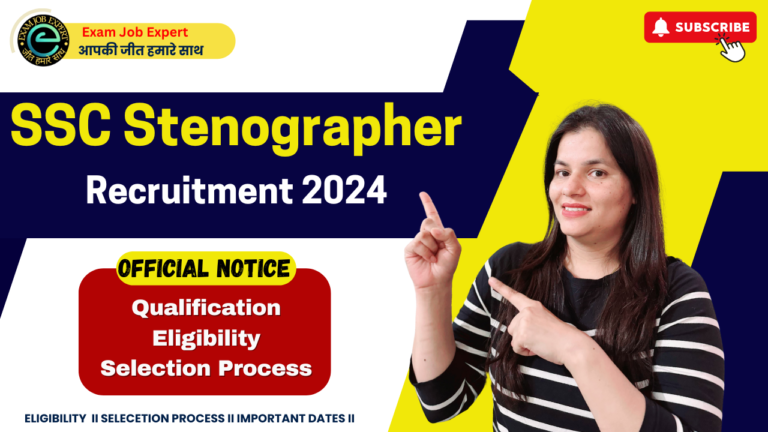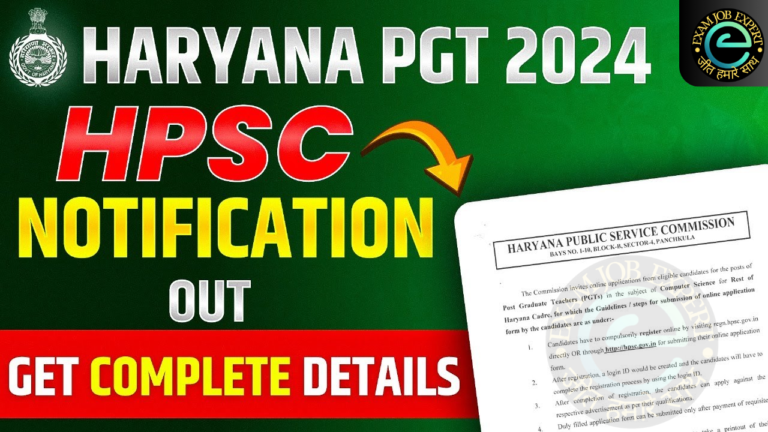GATE Exam Pattern & Syllabus 2025
The Graduate Aptitude Test in Engineering (GATE), is conducted every year for engineering students to secure admissions for M.E./ M.Tech/ PhD at the IITs, NIT’s, IIIT’s and CFTIs or to secure a high-profile job in a PSU. This year, the Indian Institute of Technology, Roorkee is going to conduct the GATE 2025 Exam on 1st, 2nd, 15th, and 16th February 2025. Candidates planning to appear for the GATE exam must be aware of the GATE Exam Pattern and Syllabus to plan better strategies for the exam. GATE is conducted in computer-based mode for 30 papers and one can attempt any one of these papers.
GATE Exam Pattern 2025
Candidates can check here a comprehensive overview of the GATE 2205 exam pattern in the table below:
Particulars | Details |
|---|---|
Examination Mode | Computer Based Test (CBT) |
Duration | 3 hours (180 minutes) |
Number of Subjects (Papers) | 30 |
Sections |
|
Type of Questions |
|
Questions for testing these abilities |
|
Number of Questions | 10 (GA) + 55 (subject) = 65 Questions |
Distribution of Marks in all Papers except papers AR, CY, EY, GG, MA, PH, XH and XL |
|
Distribution of Marks in papers AR, CY, EY, GG, MA, PH, XH and XL |
|
Marking Scheme | Questions carry 1 mark and 2 marks |
Negative Marking | For a wrong answer chosen in an MCQ, there will be a negative marking. For 1-mark MCQ, 1/3 mark will be deducted for a wrong answer. Likewise, for 2-mark MCQ, 2/3 mark will be deducted for a wrong answer |
GATE Syllabus
Candidates who are planning to write the GATE 2025 Paper are advised to plan their preparation strategy today and start to execute the same in an effective manner. So, students must understand the important topics and their weightage with the help of the GATE Syllabus to ace their preparation to secure a top score in the GATE 2025.
GATE Syllabus 2025 For General Aptitude
| Sl. No. | Syllabus |
| 1. | Verbal Ability |
| 2. | Quantitative Aptitude |
| 3. | Analytical Aptitude |
| 4. | Spatial Aptitude |
GATE CSE Syllabus 2025
| Topics | Sub-Topics |
| Discrete Mathematics | Propositional and first order logic. Sets, relations, functions, partial orders and lattices. Monoids, Groups. Graphs: connectivity, matching, coloring. Combinatorics: counting, recurrence relations, generating functions |
| Digital Logic | Boolean algebra. Combinational and sequential circuits. Minimization. Number representations and computer arithmetic (fixed and floating-point) |
| Computer Organization and Architecture | Machine instructions and addressing modes. ALU, data‐path and control unit. Instruction pipelining, pipeline hazards. Memory hierarchy: cache, main memory and secondary storage; I/O interface (interrupt and DMA mode) |
| Programming and Data Structures | Programming in C. Recursion. Arrays, stacks, queues, linked lists, trees, binary search trees, binary heaps, graphs |
| Algorithms | Searching, sorting, hashing. Asymptotic worst-case time and space complexity. Algorithm design techniques: greedy, dynamic programming and divide‐and‐conquer. Graph traversals, minimum spanning trees, shortest paths |
| Theory of Computation | Regular expressions and finite automata. Context-free grammars and push-down automata. Regular and contex-free languages, pumping lemma. Turing machines and undecidability. |
| Compiler Design | Lexical analysis, parsing, syntax-directed translation. Runtime environments. Intermediate code generation. Local optimization, Data flow analyses: constant propagation, liveness analysis, common subexpression elimination |
| Operating System | System calls, processes, threads, inter‐process communication, concurrency and synchronization. Deadlock. CPU and I/O scheduling. Memory management and virtual memory. File systems |
| Databases | ER‐model. Relational model: relational algebra, tuple calculus, SQL. Integrity constraints, normal forms. File organization, indexing (e.g., B and B+ trees). Transactions and concurrency control |
| Computer Networks | Concept of layering: OSI and TCP/IP Protocol Stacks; Basics of packet, circuit and virtual circuit-switching; Data link layer: framing, error detection, Medium Access Control, Ethernet bridging; Routing protocols: shortest path, flooding, distance vector and link-state routing; Fragmentation and IP addressing, IPv4, CIDR notation, Basics of IP support protocols (ARP, DHCP, ICMP), Network Address Translation (NAT); Transport layer: flow control and congestion control, UDP, TCP, sockets; Application layer protocols: DNS, SMTP, HTTP, FTP, Email |
GATE Mechanical Engineering Syllabus 2025
| Topics | Sub-Topics |
| Applied Mechanics and Design | |
| Engineering Mechanics | Free-body diagrams and equilibrium; friction and its applications including rolling friction, belt-pulley, brakes, clutches, screw jack, wedge, vehicles, etc.; trusses and frames; virtual work; kinematics and dynamics of rigid bodies in plane motion; impulse and momentum (linear and angular) and energy formulations; Lagrange’s equation |
| Mechanics of Materials | Stress and strain, elastic constants, Poisson’s ratio; Mohr’s circle for plane stress and plane strain; thin cylinders; shear force and bending moment diagrams; bending and shear stresses; concept of shear centre; deflection of beams; torsion of circular shafts; Euler’s theory of columns; energy methods; thermal stresses; strain gauges and rosettes; testing of materials with universal testing machine; testing of hardness and impact strength |
| Theory of Machines | Displacement, velocity and acceleration analysis of plane mechanisms; dynamic analysis of linkages; cams; gears and gear trains; flywheels and governors; balancing of reciprocating and rotating masses; gyroscope |
| Vibrations | Free and forced vibration of single degree of freedom systems, effect of damping; vibration isolation; resonance; critical speeds of shafts |
| Machine Design | Design for static and dynamic loading; failure theories; fatigue strength and the SN diagram; principles of the design of machine elements such as bolted, riveted and welded joints; shafts, gears, rolling and sliding contact bearings, brakes and clutches, springs |
| Fluid Mechanics and Thermal Sciences | |
| Fluid Mechanics | Fluid properties; fluid statics, forces on submerged bodies, stability of floating bodies; control-volume analysis of mass, momentum and energy; fluid acceleration; differential equations of continuity and momentum; Bernoulli’s equation; dimensional analysis; viscous flow of incompressible fluids, boundary layer, elementary turbulent flow, flow through pipes, head losses in pipes, bends and fittings; basics of compressible fluid flow |
| Heat-Transfer | Modes of heat transfer; one-dimensional heat conduction, resistance concept and electrical analogy, heat transfer through fins; unsteady heat conduction, lumped parameter system, Heisler’s charts; thermal boundary layer, dimensionless parameters in free and forced convective heat transfer, heat transfer correlations for flow over flat plates and through pipes, effect of turbulence; heat exchanger performance, LMTD and NTU methods; radiative heat transfer, Stefan-Boltzmann law, Wien’s displacement law, black and grey surfaces, view factors, radiation network analysis |
| Thermodynamics | Thermodynamic systems and processes; properties of pure substances, behavior of ideal and real gases; zeroth and first laws of thermodynamics, calculation of work and heat in various processes; second law of thermodynamics; thermodynamic property charts and tables, availability and irreversibility; thermodynamic relations |
| Applications | Power Engineering: Air and gas compressors; vapour and gas power cycles, concepts of regeneration and reheat. I.C. Engines: Air-standard Otto, Diesel and dual cycles. Refrigeration and air-conditioning: Vapour and gas refrigeration and heat pump cycles; properties of moist air, psychrometric chart, basic psychrometric processes. Turbomachinery: Impulse and reaction principles, velocity diagrams, Pelton-wheel, Francis and Kaplan turbines; steam and gas turbines |
| Materials, Manufacturing, and Industrial Engineering | |
| Engineering Materials | Structure and properties of engineering materials, phase diagrams, heat treatment, stress-strain diagrams for engineering materials |
| Casting, Forming and Joining Processes | Different types of castings, design of patterns, molds and cores; solidification and cooling; riser and gating design. Plastic deformation and yield criteria; fundamentals of hot and cold working processes; load estimation for bulk (forging, rolling, extrusion, drawing) and sheet (shearing, deep drawing, bending) metal forming processes; principles of powder metallurgy. Principles of welding, brazing, soldering and adhesive bonding |
| Machining and Machine Tool Operations | Mechanics of machining; basic machine tools; single and multi-point cutting tools, tool geometry and materials, tool life and wear; economics of machining; principles of non-traditional machining processes; principles of work holding, jigs and fixtures; abrasive machining processes; NC/CNC machines and CNC programming |
| Metrology and Inspection | Limits, fits and tolerances; linear and angular measurements; comparators; interferometry; form and finish measurement; alignment and testing methods; tolerance analysis in manufacturing and assembly; concepts of coordinate-measuring machine (CMM) |
| Computer Integrated Manufacturing | Basic concepts of CAD/CAM and their integration tools; additive manufacturing |
| Production Planning and Control | Forecasting models, aggregate production planning, scheduling, materials requirement planning; lean manufacturing |
| Inventory Control | Deterministic models; safety stock inventory control systems |
| Operations Research | Linear programming, simplex method, transportation, assignment, network flow models, simple queuing models, PERT and CPM |
GATE Electrical Syllabus 2025
| Topics | Sub-Topics |
| Electric Circuits: Network elements | ideal voltage and current sources, dependent sources, R, L, C, M elements; Network solution methods: KCL, KVL, Node and Mesh analysis; Network Theorems: Thevenin’s, Norton’s, Superposition and Maximum Power Transfer theorem; Transient response of dc and ac networks, sinusoidal steady-state analysis, resonance, two port networks, balanced three phase circuits, star-delta transformation, complex power and power factor in ac circuits |
| Electromagnetic Fields | Coulomb’s Law, Electric Field Intensity, Electric Flux Density, Gauss’s Law, Divergence, Electric field and potential due to point, line, plane and spherical charge distributions, Effect of dielectric medium, Capacitance of simple configurations, Biot‐Savart’s law, Ampere’s law, Curl, Faraday’s law, Lorentz force, Inductance, Magnetomotive force, Reluctance, Magnetic circuits, Self and Mutual inductance of simple configurations |
| Signals and Systems | Representation of continuous and discrete-time signals, shifting and scaling properties, linear time-invariant and causal systems, Fourier series representation of continuous and discrete-time periodic signals, sampling theorem, Applications of Fourier Transform for continuous and discrete-time signals, Laplace Transform and Z transform. R.M.S. value, average value calculation for any general periodic waveform |
| Electrical Machines | Single-phase transformer: equivalent circuit, phasor diagram, open circuit and short circuit tests, regulation and efficiency; Three-phase transformers: connections, vector groups, parallel operation; Auto-transformer, Electromechanical energy conversion principles; DC machines: separately excited, series and shunt, motoring and generating mode of operation and their characteristics, speed control of dc motors; Three-phase induction machines: principle of operation, types, performance, torque-speed characteristics, no-load and blocked-rotor tests, equivalent circuit, starting and speed control; Operating principle of single-phase induction motors; Synchronous machines: cylindrical and salient pole machines, performance and characteristics, regulation and parallel operation of generators, starting of synchronous motors; Types of losses and efficiency calculations of electric machines |
| Power Systems | Basic concepts of electrical power generation, ac and dc transmission concepts, Models and performance of transmission lines and cables, Economic Load Dispatch (with and without considering transmission losses), Series and shunt compensation, Electric field distribution and insulators, Distribution systems, Per‐unit quantities, Bus admittance matrix, Gauss-Seidel and Newton-Raphson load flow methods, Voltage and Frequency Control, Power factor correction, Symmetrical components, Symmetrical and unsymmetrical fault analysis, Principles of overcurrent, differential, directional and distance protection; Circuit breakers, System stability concepts, Equal area criterion |
| Control Systems | Mathematical modeling and representation of systems, Feedback principle, transfer function, Block diagrams and signal flow graphs, Transient and Steady‐state analysis of linear time-invariant systems, Stability analysis using Routh-Hurwitz and Nyquist criteria, Bode plots, root loci, Lag, Lead and Lead‐Lag compensators; P, PI and PID controllers; State-space model, Solution of state equations of LTI systems |
| Electrical and Electronic Measurements | Bridges and Potentiometers, Measurement of voltage, current, power, energy and power factor; Instrument transformers, Digital voltmeters and multimeters, Phase, Time and Frequency measurement; Oscilloscopes, Error analysis |
| Analog and Digital Electronics | Simple diode circuits: clipping, clamping, rectifiers; Amplifiers: biasing, equivalent circuit and frequency response; oscillators and feedback amplifiers; operational amplifiers: characteristics and applications; single-stage active filters, Active Filters: Sallen Key, Butterwoth, VCOs and timers, combinatorial and sequential logic circuits, multiplexers, demultiplexers, Schmitt triggers, sample and hold circuits, A/D and D/A converters |
| Power Electronics | Static V-I characteristics and firing/gating circuits for Thyristor, MOSFET, IGBT; DC to DC conversion: Buck, Boost and Buck-Boost Converters; Single and three-phase configuration of uncontrolled rectifiers; Voltage and Current commutated Thyristor based converters; Bidirectional ac to dc voltage source converters; Magnitude and Phase of line current harmonics for uncontrolled and thyristor-based converters; Power factor and Distortion Factor of ac to dc converters; Single-phase and three-phase voltage and current source inverters, sinusoidal pulse width modulation |
GATE IE Syllabus 2025
| Subject | Topics |
| Engineering Mathematics |
|
| Electricity and Magnetism | Coulomb’s Law, Electric Field Intensity, Electric Flux Density, Gauss’s Law, Divergence, Electric field and potential due to point, line, plane, and spherical charge distributions, Effect of the dielectric medium, Capacitance of simple configurations, Biot‐Savart’s law, Ampere’s law, Curl, Faraday’s law, Lorentz force, Inductance, Magnetomotive force, Reluctance, Magnetic circuits, Self and Mutual inductance of simple configurations. |
| Electrical Circuits and Machines | Voltage and current sources: independent, dependent, ideal and practical; v-i relationships of resistor, inductor, mutual inductance and capacitor; transient analysis of RLC circuits with dc excitation. Kirchoff’s laws, mesh and nodal analysis, superposition, Thevenin, Norton, maximum power transfer and reciprocity theorems. Peak-, average- and rms values of ac quantities; apparent-, active- and reactive powers; phasor analysis, impedance and admittance; series and parallel resonance, locus diagrams, realization of basic filters with R, L and C elements. transient analysis of RLC circuits with ac excitation. One-port and two-port networks, driving point impedance and admittance, open-, and short circuit parameters. Single-phase transformer: equivalent circuit, phasor diagram, open circuit and short circuit tests, regulation and efficiency; Three-phase induction motors: principle of operation, types, performance, torque-speed characteristics, no-load and blocked rotor tests, equivalent circuit, starting and speed control; Types of losses and efficiency calculations of electric machines |
| Signals and Systems | Periodic, aperiodic and impulse signals; Laplace, Fourier and z-transforms; transfer function, frequency response of first and second-order linear time-invariant systems, impulse response of systems; convolution, correlation. Discrete-time system: impulse response, frequency response, pulse transfer function; DFT and FFT; basics of IIR and FIR filters. |
| Control Systems | Feedback principles, signal flow graphs, transient response, steady-state-errors, Bode plot, phase and gain margins, Routh and Nyquist criteria, root loci, design of lead, lag and lead-lag compensators, state-space representation of systems; time-delay systems; mechanical, hydraulic and pneumatic system components, synchro pair, servo and stepper motors, servo valves; on-off, P, PI, PID, cascade, feedforward, and ratio controllers, tuning of PID controllers and sizing of control valves. |
| Analog Electronics | Characteristics and applications of diode, Zener diode, BJT and MOSFET; small-signal analysis of transistor circuits, feedback amplifiers. Characteristics of ideal and practical operational amplifiers; applications: adder, subtractor, integrator, differentiator, difference amplifier, instrumentation amplifier, precision rectifier, active filters, oscillators, signal generators, voltage-controlled oscillators and phase-locked loop, sources and effects of noise and interference in electronic circuits. |
| Digital Electronics | Combinational logic circuits, minimization of Boolean functions. IC families: TTL and CMOS. Arithmetic circuits, comparators, Schmitt trigger, multi-vibrators, sequential circuits, flipflops, shift registers, timers and counters; sample-and-hold circuit, multiplexer, analog-to-digital (successive approximation, integrating, flash and sigma-delta) and digital-to-analog converters (weighted R, R-2R ladder and current steering logic). Characteristics of ADC and DAC (resolution, quantization, significant bits, conversion/settling time); basics of number systems, Embedded Systems: Microprocessor and microcontroller applications, memory and input-output interfacing; basics of data acquisition systems, basics of distributed control systems (DCS) and programmable logic controllers (PLC). |
| Measurements | SI units, standards (R,L,C, voltage, current and frequency), systematic and random errors in measurement, expression of uncertainty – accuracy and precision, propagation of errors, linear and weighted regression. Bridges: Wheatstone, Kelvin, Megohm, Maxwell, Anderson, Schering and Wien for measurement of R, L, Cand frequency, Q-meter. Measurement of voltage, current and power in single and three phase circuits; ac and dc current probes; true rms meters, voltage and current scaling, instrument transformers, timer/counter, time, phase and frequency measurements, digital voltmeter, digital multimeter; oscilloscope, shielding and grounding. |
| Sensors and Industrial Instrumentation | Resistive-, capacitive-, inductive-, piezoelectric-, Hall effect sensors and associated signal conditioning circuits; transducers for industrial instrumentation: displacement (linear and angular), velocity, acceleration, force, torque, vibration, shock, pressure (including low pressure), flow (variable head, variable area, electromagnetic, ultrasonic, turbine and open channel flow meters) temperature (thermocouple, bolometer, RTD (3/4 wire), thermistor, pyrometer and semiconductor); liquid level, pH, conductivity and viscosity measurement. 4-20 mA two-wire transmitter. |
| Communication and Optical Instrumentation | Amplitude- and frequency modulation and demodulation; Shannon’s sampling theorem, pulse code modulation; frequency and time division multiplexing, amplitude-, phase-, frequency-, quadrature amplitude, pulse shift keying for digital modulation; optical sources and detectors: LED, laser, photo-diode, light-dependent resistor, square-law detectors, and their characteristics; interferometer: applications in metrology; basics of fiber optic sensing. UV-VIS Spectrophotometers, Mass spectrometer. |
GATE CE Syllabus 2025
| Topics | Sub-Topics |
| Structural Engineering | |
| Engineering Mechanics | System of forces, free-body diagrams, equilibrium equations; Internal forces in structures; Frictions and its applications; Centre of mass; Free Vibrations of undamped SDOF system |
| Solid Mechanics | Bending moment and shear force in statically determinate beams; Simple stress and strain relationships; Simple bending theory, flexural and shear stresses, shear centre; Uniform torsion, Transformation of stress; buckling of column, combined and direct bending stresses |
| Structural Analysis | Statically determinate and indeterminate structures by force/ energy methods; Method of superposition; Analysis of trusses, arches, beams, cables and frames; Displacement methods: Slope deflection and moment distribution methods; Influence lines; Stiffness and flexibility methods of structural analysis |
| Construction Materials and Management | Construction Materials: Structural Steel – Composition, material properties and behavior; Concrete – Constituents, mix design, short-term and long-term properties. Construction Management: Types of construction projects; Project planning and network analysis – PERT and CPM; Cost estimation |
| Concrete Structures | Working stress and Limit state design concepts; Design of beams, slabs, columns; Bond and development length; Prestressed concrete beams |
| Steel Structures | Working stress and Limit state design concepts; Design of tension and compression members, beams and beam-columns, column bases; Connections – simple and eccentric, beam-column connections, plate girders and trusses; Concept of plastic analysis -beams and frames |
| Geotechnical Engineering | |
| Soil Mechanics | Three-phase system and phase relationships, index properties; Unified and Indian standard soil classification system; Permeability – one-dimensional flow, Seepage through soils – two – dimensional flow, flow nets, uplift pressure, piping, capillarity, seepage force; Principle of effective stress and quicksand condition; Compaction of soils; One- dimensional consolidation, time rate of consolidation; Shear Strength, Mohr’s circle, effective and total shear strength parameters, Stress-Strain characteristics of clays and sand; Stress paths |
| Foundation Engineering | Sub-surface investigations – Drilling boreholes, sampling, plate load test, standard penetration and cone penetration tests; Earth pressure theories – Rankine and Coulomb; Stability of slopes – Finite and infinite slopes, Bishop’s method; Stress distribution in soils – Boussinesq’s theory; Pressure bulbs, Shallow foundations – Terzaghi’s and Meyerhoff’s bearing capacity theories, effect of water table; Combined footing and raft foundation; Contact pressure; Settlement analysis in sands and clays; Deep foundations – dynamic and static formulae, Axial load capacity of piles in sands and clays, pile load test, pile under lateral loading, pile group efficiency, negative skin friction |
| Water Resources Engineering | |
| Fluid Mechanics | Properties of fluids, fluid statics; Continuity, momentum and energy equations and their applications; Potential flow, Laminar and turbulent flow; Flow in pipes, pipe networks; Concept of boundary layer and its growth; Concept of lift and drag |
| Hydraulics | Forces on immersed bodies; Flow measurement in channels and pipes; Dimensional analysis and hydraulic similitude; Channel Hydraulics – Energy-depth relationships, specific energy, critical flow, hydraulic jump, uniform flow, gradually varied flow and water surface profiles |
| Hydrology | Hydrologic cycle, precipitation, evaporation, evapotranspiration, watershed, infiltration, unit hydrographs, hydrograph analysis, reservoir capacity, flood estimation and routing, surface runoff models, groundwater hydrology – steady state well hydraulics and aquifers; Application of Darcy’s Law |
| Irrigation | Types of irrigation systems and methods; Crop water requirements – Duty, delta, evapotranspiration; Gravity Dams and Spillways; Lined and unlined canals, Design of weirs on permeable foundation; cross drainage structures |
| Environmental Engineering | |
| Water and Waste Water Quality and Treatment | Basics of water quality standards – Physical, chemical and biological parameters; Water quality index; Unit processes and operations; Water requirement; Water distribution system; Drinking water treatment; Sewerage system design, quantity of domestic wastewater, primary and secondary treatment. Effluent discharge standards; Sludge disposal; Reuse of treated sewage for different applications |
| Air Pollution | Types of pollutants, their sources and impacts, air pollution control, air quality standards, Air quality Index and limits |
| Municipal Solid Wastes | Characteristics, generation, collection and transportation of solid wastes, engineered systems for solid waste management (reuse/ recycle, energy recovery, treatment and disposal) |
| Transportation Engineering | |
| Transportation Infrastructure | Geometric design of highways – cross-sectional elements, sight distances, horizontal and vertical alignments. Geometric design of railway Track – Speed and Cant. Concept of airport runway length, calculations and corrections; taxiway and exit taxiway design |
| Highway Pavements | Highway materials – desirable properties and tests; Desirable properties of bituminous paving mixes; Design factors for flexible and rigid pavements; Design of flexible and rigid pavement using IRC codes |
| Traffic Engineering | Traffic studies on flow and speed, peak hour factor, accident study, statistical analysis of traffic data; Microscopic and macroscopic parameters of traffic flow, fundamental relationships; Traffic signs; Signal design by Webster’s method; Types of intersections; Highway capacity |
| Geomatics Engineering | |
| Geomatics Engineering | Principles of surveying; Errors and their adjustment; Maps – scale, coordinate system; Distance and angle measurement – Levelling and trigonometric levelling; Traversing and triangulation survey; Total station; Horizontal and vertical curves. Photogrammetry and Remote Sensing – Scale, flying height; Basics of remote sensing and GIS |
GATE ECE Syllabus 2025
| Sl. No. | Sections | Topic-Wise Syllabus |
| 1 | Engineering Mathematics |
|
| 2 | Networks, Signals and Systems | Circuit analysis: Node and mesh analysis, superposition, Thevenin’s theorem, Norton’s theorem, reciprocity. Sinusoidal steady state analysis: phasors, complex power, maximum power transfer. Time and frequency domain analysis of linear circuits: RL, RC and RLC circuits, solution of network equations using Laplace transform, Linear 2-port network parameters, wye-delta transformation
Continuous-time signals: Fourier series and Fourier transform, sampling theorem and applications Discrete-time signals: DTFT, DFT, z-transform, discrete-time processing of continuous-time signals. LTI systems: definition and properties, causality, stability, impulse response, convolution, poles and zeroes, frequency response, group delay, phase delay |
| 3 | Electronic Devices |
|
| 4 | Analog Circuits |
|
| 5 | Digital Circuits |
|
| 6 | Control Systems | Basic control system components; Feedback principle; Transfer function; Block diagram representation; Signal flow graph; Transient and steady-state analysis of LTI systems; Frequency response; Routh-Hurwitz and Nyquist stability criteria; Bode and root-locus plots; Lag, lead and lag-lead compensation; State variable model and solution of state equation of LTI systems. |
| 7 | Communications |
|
| 8 | Electromagnetics |
|







